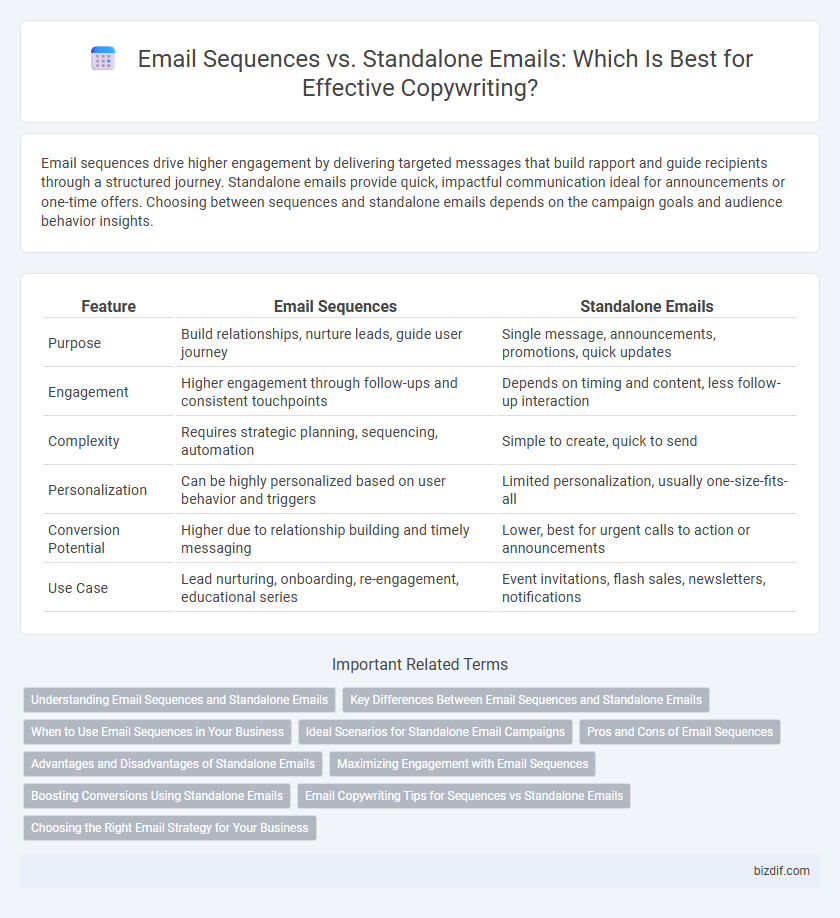Email sequences drive higher engagement by delivering targeted messages that build rapport and guide recipients through a structured journey. Standalone emails provide quick, impactful communication ideal for announcements or one-time offers. Choosing between sequences and standalone emails depends on the campaign goals and audience behavior insights.
Table of Comparison
| Feature | Email Sequences | Standalone Emails |
|---|---|---|
| Purpose | Build relationships, nurture leads, guide user journey | Single message, announcements, promotions, quick updates |
| Engagement | Higher engagement through follow-ups and consistent touchpoints | Depends on timing and content, less follow-up interaction |
| Complexity | Requires strategic planning, sequencing, automation | Simple to create, quick to send |
| Personalization | Can be highly personalized based on user behavior and triggers | Limited personalization, usually one-size-fits-all |
| Conversion Potential | Higher due to relationship building and timely messaging | Lower, best for urgent calls to action or announcements |
| Use Case | Lead nurturing, onboarding, re-engagement, educational series | Event invitations, flash sales, newsletters, notifications |
Understanding Email Sequences and Standalone Emails
Email sequences consist of multiple, strategically timed messages designed to guide recipients through a customer journey, enhancing engagement and conversion rates. Standalone emails function as single, independent communications aimed at delivering a specific message or call to action without follow-up. Understanding the distinction enables copywriters to effectively tailor content, optimize email marketing strategies, and improve overall campaign performance.
Key Differences Between Email Sequences and Standalone Emails
Email sequences consist of a series of strategically timed messages designed to nurture leads and guide prospects through a sales funnel, whereas standalone emails are single communications intended for specific, immediate actions or announcements. Sequences leverage automation and personalized content flow to build engagement over time, while standalone emails often focus on delivering one-off promotional offers, updates, or reminders. The key difference lies in the purpose and structure: sequences aim for long-term relationship development, whereas standalone emails target quick, direct responses.
When to Use Email Sequences in Your Business
Email sequences are ideal for nurturing leads and guiding prospects through a structured sales funnel by delivering targeted, timely content that builds trust and encourages conversions. Businesses benefit from sequences when launching new products, onboard new subscribers, or promoting multi-step offers requiring detailed explanation and engagement. Consistent touchpoints in sequences increase open rates and customer retention compared to standalone emails, which are better suited for one-time announcements or quick updates.
Ideal Scenarios for Standalone Email Campaigns
Standalone email campaigns excel in promoting time-sensitive offers, product launches, or event invitations where immediate action is crucial. They are ideal for targeting segmented audiences with personalized messages that drive quick engagement without the need for follow-up sequences. Brands use standalone emails to deliver concise, impactful content that captures attention and boosts conversions in a single communication.
Pros and Cons of Email Sequences
Email sequences enhance engagement by delivering targeted messages in a structured flow, which nurtures leads and increases conversion rates more effectively than standalone emails. They require careful planning and automation tools, posing a higher initial time investment and complexity in crafting personalized content. However, their ability to build relationships and guide prospects through the sales funnel outweighs these challenges, making sequences ideal for long-term marketing success.
Advantages and Disadvantages of Standalone Emails
Standalone emails offer the advantage of quick, focused communication, allowing marketers to deliver a single, impactful message without the complexity of a series. They are ideal for urgent promotions or announcements but lack the sustained engagement and storytelling potential found in email sequences. However, standalone emails may result in lower conversion rates due to limited follow-up opportunities and reduced ability to nurture leads over time.
Maximizing Engagement with Email Sequences
Email sequences create a structured flow that nurtures leads through personalized, timely messages, significantly boosting open rates and click-through performance compared to standalone emails. By delivering tailored content at strategic intervals, sequences build trust and encourage ongoing interaction, resulting in higher conversion rates. Implementing automated email sequences allows marketers to maintain consistent engagement, optimize customer journeys, and maximize overall campaign effectiveness.
Boosting Conversions Using Standalone Emails
Standalone emails deliver targeted, high-impact messages that drive immediate action, making them ideal for boosting conversions. By focusing on a singular, clear call-to-action, standalone emails reduce distractions and increase click-through rates. Strategic timing and personalized content within standalone emails effectively enhance engagement and overall campaign ROI.
Email Copywriting Tips for Sequences vs Standalone Emails
Effective email copywriting for sequences emphasizes a cohesive narrative and progressive engagement, integrating personalized triggers and strategic spacing to nurture leads over time. Standalone emails demand concise, compelling messaging with a clear single call-to-action, optimized for immediate impact and higher open-to-click rates. Understanding subscriber behavior and segmenting audiences enhances both approaches, ensuring relevance and maximizing conversion potential.
Choosing the Right Email Strategy for Your Business
Email sequences create a structured flow that nurtures leads and guides them through the sales funnel with timed, relevant messages, increasing conversion rates. Standalone emails are ideal for one-time announcements or promotions that require immediate attention without a follow-up series. Selecting the right strategy depends on your business goals, audience behavior, and the complexity of your sales process.
Email Sequences vs Standalone Emails Infographic

 bizdif.com
bizdif.com